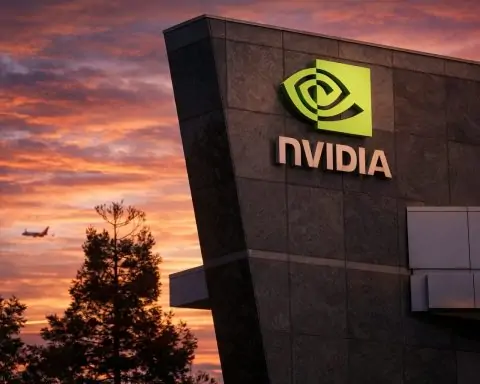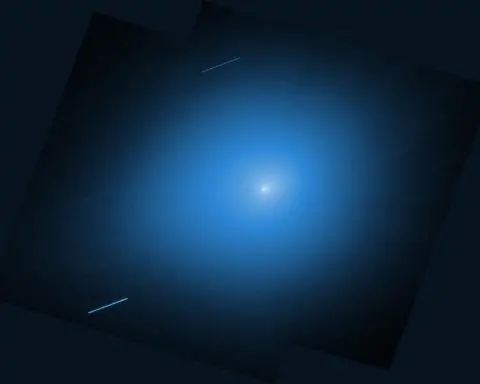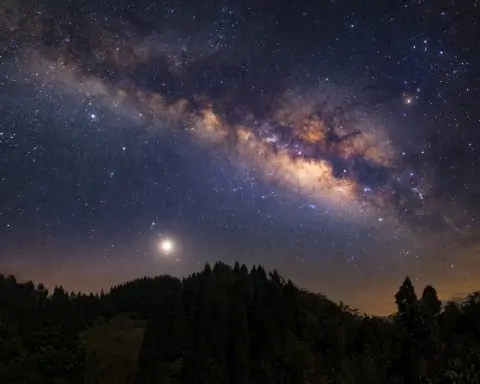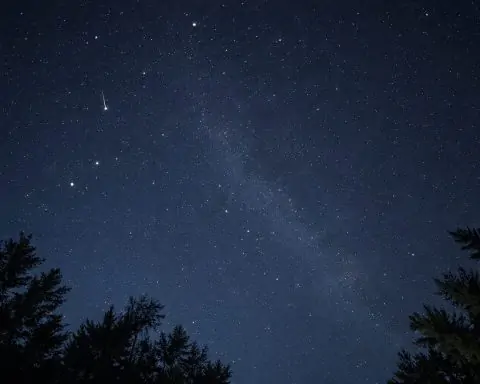- Moonless Nights for Stargazing: A rare Black Moon on August 23 has left the nights of Aug. 27–28 dark and ideal for star-spotting [1]. A slim crescent Moon returns at dusk, creating scenic sunsets and pairing up with Mars low in the west [2].
- Lingering “Shooting Stars”: The Perseid meteor shower has tapered off (active until Aug. 24 [3]), but a few meteors per hour can still streak across the sky before dawn. Minor showers like the Aurigids are just beginning around Aug. 27, though only a handful of meteors are expected [4].
- Planets on Parade: Saturn rises by mid-evening, shining bright in Pisces and visible all night [5]. Jupiter and dazzling Venus grace the pre-dawn eastern sky, easily outshining the stars [6]. Mars appears briefly at sunset, very low on the horizon near the young Moon [7].
- Aurora Alert – Minor Geomagnetic Storm: The Sun has been active with multiple moderate (M-class) solar flares [8], and a high-speed solar wind stream is buffeting Earth. Space weather forecasters say this could spark unsettled geomagnetic conditions Aug. 27, with a slight chance of a G1 (Minor) auroral storm [9]. High-latitude skywatchers might glimpse faint auroras on these nights if the geomagnetic activity ticks up [10].
- Rocket Launches & Satellite Sights:SpaceX is scheduled to launch Starlink internet satellites twice – on Aug. 27 at dawn and again just after midnight on Aug. 28 [11] [12]. These may produce glowing rocket trails in the twilight sky and “satellite trains” of bright lights after deployment [13] [14]. A Blue Origin suborbital rocket flight (carrying student experiments) was slated for Aug. 27 but has been postponed due to a technical issue [15].
- Space Station Flyovers: The ISS continues its routine orbits and can be spotted as a bright, fast-moving “star” at certain times around dawn or dusk. According to NASA, when visible the ISS is often the brightest object in the night sky after the Moon [16]. Check NASA’s “Spot the Station” service for flyover times in your area – for example, observers in Europe can catch the Station passing high overhead in the early morning hours this week (specific timings vary by location) [17] [18].
Moonless “Black Moon” Nights & Meteor Sightings
Late August 2025 offers especially dark nights for skywatchers. The new moon on August 23 was the third new moon in a season with four (an event sometimes nicknamed a “Black Moon”) [19]. This means no bright moonlight to outshine the stars on August 27–28. In fact, the slim crescent Moon is just beginning to reappear at sunset, only ~4–5 days old. On the evening of Aug. 26 it made a close pass by Mars in the twilight sky [20], and on Aug. 27–28 you’ll find the young Moon still hovering low in the southwest after sundown, with ruddy Mars a few degrees to its right. Both set relatively soon after dusk (within an hour or two) [21], so catch this pretty pairing early. Observers in lower latitudes (e.g. U.S. Gulf Coast or Southern Europe) will see the Moon and Mars a bit higher and easier in the sky [22], while those farther north will have them very close to the horizon at nightfall [23].
With the late-August Moon mostly out of the way, it’s a great time for meteor hunting. The famous Perseid meteor shower has officially ended its peak—Earth’s crossing of Comet Swift-Tuttle’s debris runs from July 17 to about August 24 each year [24]. By this week, the Perseids’ activity has dwindled dramatically: meteor experts at the American Meteor Society note that by the third week of August, Perseid rates drop below 5 meteors per hour under dark skies [25]. (Contrast this with 50+/hour at the August 12–13 peak in ideal conditions.) Still, sporadic “shooting stars” continue at a background rate of ~15–20 per hour in pre-dawn hours for vigilant observers [26] [27]. And a few late Perseid stragglers or other minor-shower meteors may flash across the sky – especially just before dawn when Earth’s rotation faces you into the oncoming meteor streams.
Interestingly, a minor meteor shower is on the rise: the Aurigids. The first Aurigid meteors are expected around August 27 in the pre-dawn hours [28]. This shower, originating from Comet Kiess, is typically very sparse – normally only a few meteors per hour at best during its peak on Aug. 31 [29]. (Historically it surprised observers with rare outbursts in 1935 and 1986, but none are predicted this year.) So you might not notice any obvious uptick in meteors from it on the 27th–28th, but it’s good to know the Aurigids are starting to sprinkle our skies. Essentially, any meteors you see this week will likely be either late Perseids, early Aurigids, or random sporadics. The good news is that the Moon’s absence means pristine dark conditions, so if a meteor does blaze by, even a faint one, you have a better chance of catching it. Get to a dark site, let your eyes adapt, and you might be rewarded with the occasional shooting star zipping through the summer constellations.
“A few bright meteors may still be seen in the pre-dawn hours, but viewing conditions are not ideal this year,” NASA noted of the Perseids during their peak (which was spoiled by moonlight in 2025) [30]. Now as we head into late August, the situation is reversed: the viewing conditions are excellent, but the meteor activity is low. Patience is key – plan to spend at least an hour or more under the stars for a decent chance to catch a handful of meteors. You can improve your odds by watching after midnight and before dawn, when your location on Earth faces forward into the meteor streams, increasing the rate [31] [32]. Dress warmly, get a comfortable chair or blanket, and scan the sky. Even one or two bright fireballs can make the vigil worthwhile (and the Milky Way views this time of year, with no moon, are spectacular on their own).
Planets: Saturn Shines, Jupiter & Venus at Dawn
The planetary lineup this week is a treat, with all five naked-eye planets visible at some point each night, plus Uranus and Neptune for telescope users. Here’s what to look for on Aug. 27–28:
- Mars – The dimmest of the naked-eye planets right now – it’s far from Earth – Mars appears very low in the west after sunset [33]. It’s about magnitude +1.7 (similar to a medium-bright star) and sets roughly 1–2 hours after the Sun. Look for a faint reddish “star” to the right of the slim crescent Moon at dusk on these dates. In mid-northern latitudes, Mars may be tough to spot in the bright twilight without binoculars [34], but farther south where it’s a bit higher, you can use the young Moon’s position to guide you to Mars [35]. By around 9 p.m. local time, Mars will have sunk below the horizon [36]. Catch it while you can – after this month, Mars disappears into the Sun’s glare for a while.
- Saturn – The ringed planet is currently at its brightest and best, as it reaches opposition (its yearly closest approach) in late August. Saturn rises in the east around 8:30–9:00 p.m. local time by the end of August [37]. On Aug. 27, look east in late evening for a steady, golden “star” coming up. Saturn climbs higher through the night and is due south at its highest around 2–3 a.m. [38]. It shines at about magnitude 0.4–0.5, outshining most stars in its area. Saturn currently lies in the constellation Pisces, which has no bright stars, so Saturn stands out clearly [39]. Fun fact: In a telescope, Saturn’s rings are nearly edge-on this year (the planet’s tilt relative to us is low), so the rings appear as a thin line – a rare view we get only around every 15 years. If you have binoculars, you might just make out Saturn as non-star-like, but a telescope is needed to truly enjoy the rings and Saturn’s brightest moon Titan. Saturn will be observable all night on Aug. 27–28, and it won’t set until well after sunrise for many locations [40].
- Jupiter – The largest planet rises in the east after midnight. By 2–3 a.m. local time on Aug. 28, Jupiter is up and shining brilliantly in the east [41]. It’s unmistakable: at magnitude –2.5, Jupiter is extremely bright, brighter than any star. In the predawn hours, you’ll see it high in the east/southeast, in the constellation Gemini (near the twin stars Castor and Pollux which it outshines) [42]. Jupiter is a great target for binoculars or a small scope – even hand-held binoculars will reveal its four Galilean moons as tiny star-like points lined up near the planet. If you’re out before dawn, Jupiter will catch your eye as one of the last objects still visible when the sky starts to lighten.
- Venus – After spending a couple months hidden near the Sun, Venus is back as the “Morning Star.” It currently rises about an hour after Jupiter, so roughly 3–4 a.m. local time [43]. By one hour before sunrise, Venus is about 10° above the eastern horizon (for mid-northern latitudes) and blazing at magnitude –4.5, far brighter than anything else in the sky aside from the Moon [44]. There’s no mistaking Venus – it’s the first “star” you’ll see in the dawn. If you have a very clear view of the east, you might even catch Venus and Jupiter simultaneously in the predawn darkness, shining like a cosmic “double lighthouse” beaming from the horizon. Note: Venus is still low and can be obscured by trees or buildings, so find an open view to the east. As August turns to September, Venus will climb higher and be easier to spot each morning.
- Mercury – The smallest planet is technically visible just before sunrise this week, but it’s a challenge. Mercury is reaching greatest elongation (furthest separation from the Sun) around these dates, but that’s happening during a very shallow morning apparition for the Northern Hemisphere. Around Aug. 27, Mercury rises roughly 90 minutes before sunrise, but because the ecliptic (planetary plane) is at a shallow angle, Mercury never gets very high. By dawn, it might be ~5–8° above the horizon at best. It shines around magnitude +0.5. Observers at mid-northern latitudes may struggle to see Mercury against the brightening sky; those in the tropics or Southern Hemisphere have a better geometry and slightly higher viewing. If you want to try: look extremely low in the east-northeast about 30–45 minutes before your local sunrise. Binoculars will help pick Mercury out of the glow. (Be sure to stop looking once the Sun is about to rise for safety.) Mercury will become easier to see from the Southern Hemisphere morning sky going into early September, but for most casual skywatchers up north, it’s not prominent now.
In summary, the best planet sights on Aug. 27–28 are Saturn in mid-to-late evening, then Jupiter and Venus shining in the early morning hours. Saturn’s around all night; Jupiter pops up after midnight, and Venus steals the show at dawn. If you’re up in the evening, you also get the lovely view of the thin crescent Moon with Mars (albeit faint) just after sunset. And if you have a telescope, note that Neptune (magnitude ~7.8) is actually not far from Saturn in the sky – it had a very close conjunction with Saturn earlier in August [45]. By late August they’re a couple degrees apart in Pisces. You’d need optics to see Neptune, but it’s neat to know that two very different worlds – Saturn with its rings, and blue-green Neptune – are currently neighbors in our line of sight.
Auroras & Space Weather: Mild Solar Storm Watch
Skywatchers at high latitudes, keep an eye out for the aurora borealis (or australis, in the Southern Hemisphere) on the nights of Aug. 27–28. While no major geomagnetic storm is guaranteed, there is a chance of a minor auroral display due to recent solar activity.
Here’s the situation: The Sun has been ramping up in activity as it heads toward solar maximum (expected around 2025–2026). In the past few days, solar observatories recorded a flurry of moderate solar flares – five M-class flares between August 25–26 alone [46] – from two new sunspot regions just rotating into view. “Action is picking up on the eastern solar disk,” reported NASA solar scientist C. Alex Young, noting that these active regions “are setting the stage for more volatile days ahead” [47]. The largest flare was a strong M4.5 burst on Aug. 26 [48]. Solar flares of that size can cause brief radio blackouts on the sunlit side of Earth, but more importantly for auroras, flares sometimes coincide with coronal mass ejections (CMEs) — clouds of charged plasma that, if directed at Earth, can trigger geomagnetic storms.
Fortunately (or unfortunately for aurora-chasers), none of those recent flares produced an Earth-directed CME [49]. So there’s no major solar storm headed straight for us from those eruptions. However, the Sun has another trick: a large coronal hole in its atmosphere has been spewing a high-speed solar wind stream toward Earth [50]. This stream of fast particles was expected to reach Earth around August 26–27. When such solar wind streams interact with Earth’s magnetic field, they can disturb it and cause geomagnetic unrest.
NOAA’s Space Weather Prediction Center and other forecasters predict “unsettled to active” geomagnetic conditions through Aug. 27, “with a slight chance of G1 (Minor) storming” [51]. In other words, Earth’s magnetic field may be rattled enough to possibly produce a Kp 5 event on the NOAA scale – that’s the lowest level of geomagnetic storm. G1 storms can drive auroras a bit farther from the poles than usual. If it materializes, people in high-latitude regions like Canada, Alaska, Northern Europe (Scotland, Scandinavia, etc.), or the far southern tip of New Zealand/Tasmania might see a gentle auroral glow or modest curtains of light low on the horizon [52].
As of the evening of Aug. 27, conditions have been mostly quiet to unsettled (Kp 2–3) [53], meaning the aurora is largely confined to the usual polar zones. But geomagnetic forecasts show the influence of the coronal hole waning by Aug. 28 [54]. So if you’re hoping to catch the Northern Lights, the night of the 27th into 28th is your best shot during this window. It’s a low-probability, but not zero: auroras have surprised forecasters before.
Even if you’re not in the auroral zone, it’s interesting to note the Sun’s recent behavior. Along with the flares, there was a minor solar radiation storm on Aug. 25 when energetic particles from a far-side flare reached Earth, hitting S1 level (minor) [55] [56]. That mainly affects satellites and high-altitude polar flights with increased radiation, but it shows the Sun is getting feisty. The solar flux (a measure of sunspot activity) is elevated, and more sunspots are emerging.
Experts like NASA and NOAA remain on alert. They emphasize there is no danger to people on the ground – even a G1 geomagnetic storm is benign, apart from possibly causing auroras and minor impacts on some radio or GPS signals. A NOAA space weather update on Aug. 26 indicated that geomagnetic storm levels might briefly reach G1, and that “a coronal hole high-speed stream is expected to elevate geomagnetic conditions from August 26 to 27” [57]. By Aug. 28 things should calm back to normal (Kp 3 or below) [58].
If you’re in a place like northern Canada, Alaska, Iceland, Norway, etc., keep an eye to the north after local midnight. With the Moon absent from the sky and the nights growing longer as summer wanes, conditions are good for spotting any faint aurora if it occurs. Look for a greenish or reddish diffuse glow or shifting curtains. If a G1 storm happens, auroras could possibly be visible down into, say, the northern-tier U.S. states (Montana, North Dakota, maybe northern Michigan/Maine) or similar latitudes in Europe (Ireland, Denmark, etc.), though likely low on the horizon. It’s far from a sure thing – consider it an aurora watch, not a warning.
For real-time updates, you can check resources like NOAA’s Aurora Forecast or sites like Spaceweather.com, which often post alerts if geomagnetic activity spikes. As of now, it’s a wait-and-see game. Even a minor aurora would be a bonus surprise to cap off the late-August sky shows.
(Expert tip: Dr. Tamitha Skov, a space weather physicist, often provides accessible forecasts on social media. Around Aug. 19 she alerted that a solar wind stream was on its way and could bring auroras, though expecting only minor effects. Always fun to follow if you’re into aurora hunting!)
Rocket Launches on Aug 27–28: SpaceX Starlink Double-Header
Our skies are not just graced by natural phenomena – humans are busy in space this week too. Rocket launch activity on August 27 and 28 will be of interest, especially to those living near Florida’s Space Coast or who enjoy catching a glimpse of satellites overhead.
SpaceX has two Falcon 9 launches scheduled in this 48-hour span, both carrying batches of the company’s Starlink satellites (which provide global internet service):
- Aug. 27 – Cape Canaveral, Florida: A Falcon 9 is slated to lift off at 6:53 a.m. EDT (1053 GMT) from Space Launch Complex 40, deploying a group of Starlink satellites into low-Earth orbit [59]. This is around local sunrise time on the Florida coast. Early-morning launches can create a spectacular “jellyfish” effect: the exhaust plume might catch sunlight in the upper atmosphere, fanning out into a glowing cloud visible for hundreds of miles. If you’re in Florida or nearby states and awake before dawn, you might see a strange comet-like glow in the eastern sky shortly after 6:53 a.m. (weather permitting). These sunrise/sunset launches have treated observers to stunning visuals before [60]. Keep an eye out for live coverage – SpaceX often streams their launches online, and local news may cover any sonic booms from the returning Falcon 9 booster (this booster will likely land offshore on a drone ship, given it’s launching eastward, so no land landing sonic boom this time).
- Aug. 28 – Kennedy Space Center, Florida: Another Falcon 9 is planned to launch at 1:27 a.m. EDT (0527 GMT) from historic Launch Complex 39A [61]. This is just after midnight in the early hours of Thursday (late Wednesday night for U.S. time zones). Being a night launch, it will light up the sky briefly like a bright ascending star. People across central Florida could witness the rocket’s fiery ascent if skies are clear. The dark-sky launch may not produce as widespread an illuminated plume as a dawn launch, but observers near the trajectory might still see the expanding exhaust cloud faintly lit by the rocket’s flame. Shortly after launch, as the Falcon 9 heads to orbit, keen observers might even spot a chain of new Starlink satellites crossing the sky.
Each Falcon 9 will be carrying dozens of Starlink microsatellites (usually around 22 per launch for the newer V2 mini-satellites). When these satellites first deploy and start raising their orbits, they travel in a tight formation often dubbed a “Starlink train.” For a day or two after launch, you can sometimes see this string of bright pearls moving in line across the sky. “On clear nights, you may spot these satellites as they streak across the sky, resembling a string of bright, evenly spaced lights,” explains Space.com’s skywatching columnist Daisy Dobrijevic [62]. It’s a truly bizarre sight if you’ve never seen it – people have mistaken it for UFOs! If you’re in, say, the southeastern U.S. or Caribbean, watch for news of any visible passes of the freshly launched Starlinks on Aug. 27–28 evenings. Websites and apps (like Heavens-Above or FindStarlink) can predict when the new cluster might be observable at your location. Generally, you need the timing to be after sunset or before sunrise (so the satellites are in sunlight while you’re in darkness). The Aug. 27 morning launch’s batch might be visible the next evening or two in certain areas; the Aug. 28 midnight batch might be visible in pre-dawn hours shortly after launch if their orbit lines up over your region. However, note that SpaceX has been making the satellites less reflective over time, so the “train” is not as brilliant as in early days [63]. Still, it’s worth trying to catch if you have coordinates and clear skies – it’s like watching a string of moving stars.
In addition to SpaceX, Blue Origin had a suborbital launch on the calendar: the company’s New Shepard rocket (famous for its tourist flights to space) was targeting Aug. 27 at 8:30 a.m. EDT from West Texas [64]. This mission, called NS-35, is an uncrewed research flight carrying ~24 student experiments and the company’s 200th payload overall [65]. Unfortunately, as of Aug. 26, Blue Origin scrubbed the launch due to an unresolved avionics issue [66]. They had already stood down from an attempt on Aug. 23, and again on Aug. 26 the countdown was halted [67]. The company announced they’re troubleshooting the booster and will reset a new date once ready [68]. So no launch on the 27th after all. When it does fly, it’ll be a 10-minute suborbital hop, and while not widely visible to the public (except maybe a contrail if you’re near Van Horn, Texas), it’s notable for carrying STEM payloads (student-designed experiments) to the edge of space. We’ll have to watch for Blue Origin’s updates for the next launch window.
For rocket fans, it’s worth mentioning that August 26 was also supposed to feature a big event: SpaceX’s next Starship prototype flight from Boca Chica, Texas (Starbase). The SpaceX calendar listing had a Starship Flight 10 planned for Aug. 26 evening [69]. However, there’s been no official word that it occurred on that date, and given the developmental nature of Starship, schedules are highly fluid. (If it did happen and you’re reading this after the fact, it would have been a spectacle – Starship launches are massive. But most likely it’s been delayed into September pending FAA approval and technical readiness. Check SpaceX news for the latest on Starship test flights.)
Bottom line: SpaceX’s Starlink launches are the headline space events for Aug. 27–28. They highlight how routine orbital launches have become (multiple in a week), yet they still provide skywatching opportunities:
- If you live near the Florida Space Coast, you can attempt to watch the launches directly (from public viewing spots around Cape Canaveral) or look up for the rocket streak in the sky.
- For others in the Southeast U.S., a dawn launch can create a weird illuminated cloud – keep your camera ready on Aug. 27 morning.
- Everywhere else, be on the lookout for Starlink satellite trains in the days after launch. These will appear as a line of moving lights, usually best seen an hour or two after sunset or before sunrise. (They’ll fade as the satellites disperse to their higher orbits after a few days [70] [71].)
One more space-sight to mention: International Space Station flyovers. The ISS circles Earth every ~90 minutes and is often visible at dawn or dusk when sunlight hits it. Around late August, many locations are transitioning from evening visibility to morning visibility for the ISS. For example, in Warsaw, Poland (the user’s location), the ISS had a series of bright evening passes earlier in August, but by the 27th it may be appearing in the pre-dawn sky. Indeed, NASA’s “Spot the Station” data for central Europe indicates an early morning pass around 4:30–5:00 a.m. local time on these dates, low in the southwest to east (this is just an illustrative estimate; check the official schedule for exact timing!). Likewise, the northeastern US is getting some predawn ISS passes this week, whereas places like Australia might be seeing evening passes. The key is that the ISS is very bright (about magnitude –3 to –4 at maximum, rivaling Venus) and moves swiftly across the sky in a few minutes. “The International Space Station’s trajectory passes over more than 90% of Earth’s population,” NASA notes [72], so chances are you’re in a spot that gets ISS flyovers periodically. If you want to catch it on Aug. 27 or 28, go to NASA’s Spot the Station website and input your city – it will list upcoming sighting opportunities [73] [74]. Look for ones in the hour or so before sunrise or after sunset. During a good pass, the ISS appears as a steady, non-blinking white dot sliding across the sky, typically taking 3–6 minutes from one horizon to the other. No telescope needed – it’s easily visible to the naked eye (in fact, it’s often the brightest thing up there after the Moon) [75]. It’s a cool way to wave “hello” to the seven astronauts currently aboard Expedition 73!
Also, with all these Starlink launches, satellites in general are an increasingly common sight. Besides the special Starlink trains, you might see individual satellites gliding by on any clear night. For instance, Tiangong, China’s space station, is about as bright as ISS when conditions are right, and it has been making predawn passes in some regions. Apps like Heavens-Above or Stellarium can show you if any satellite flares or passes (Iridium flares are no more, but other satellites can still flare) are happening on a given night. It’s a reminder that the night sky is changing – human-made “stars” are joining the natural ones. Astronomers are concerned about this (satellite megaconstellations can interfere with observations [76]), but for casual skywatchers, spotting a satellite or space station can be a fun addition to the night’s checklist.
Final Tips and Notable Times by Region
To make the most of these nights, here’s a quick roundup by region of what to look for and when (all dates/times local):
- North America (mid-latitudes) – Evening (~8–10pm): Gorgeous sunset with a delicate crescent Moon; try to spot Mars right after sunset, to the Moon’s right (use binoculars if needed). Saturn rises in the east by 9pm; by 10–11pm it’s nicely visible. Late Night (midnight–dawn): Saturn high in south. After 2am, Jupiter bright in east; Venus follows ~4am in east – super bright. Possible ISS passes before dawn (check Spot the Station). Aug. 27 6:53am EDT Florida launch – visible along Eastern Seaboard dawn skies if you’re up. Aug. 28 1:27am EDT Florida launch – those in Florida/Georgia may see the rocket ascent around 1:30am. Aurora: Only if a G1 storm hits – areas like Canadian border states should watch north after midnight on the 27th.
- Europe (central/northern) – Evening (~9–11pm): Similar story – thin Moon low in WSW after sunset (sets quickly), Mars extremely low (likely invisible in UK/Germany latitudes due to horizon). Saturn rising in ESE around 9–10pm BST/CEST. Midnight–Dawn: Saturn south in midnight hours; Jupiter rises in ENE by ~3–4am local; Venus rising ~4–5am E to ENE (very bright!). Pre-dawn ISS passes possible (for example, London and Berlin have ISS flyovers around 5am this week). Aurora: high latitude Europe (Scotland, Scandinavia) should keep watch on 27th night – slight chance of aurora low on horizon if geomagnetic indices rise [77]. No major meteor shower, but dark skies mean you might still catch a few meteors pre-dawn. The Perseids are essentially over in Europe too (peak has passed) [78].
- Southern Hemisphere (Aus/NZ, South America) – You have the Moon & Mars pairing too, but since it’s winter for you, the Sun sets earlier and the sky gets dark quicker. Auckland/Sydney (~6–7pm): On Aug. 27 look west after sunset – you may see the 4-day-old Moon slightly higher above the horizon than northern observers do, and Mars a bit more easily (still not far from the horizon). By 8pm, Mars and the Moon will have set. Saturn rises earlier for you (it’s already up by evening in mid-southern latitudes). Late night: Jupiter comes up by 1–2am local for Australia/NZ, Venus by 3–4am – they’ll be in the east before dawn. Aurora Australis: Tasmania, NZ South Island – minor chance on Aug. 27/28 nights if that G1 storm brushes Earth; monitor Kp. ISS: likely some good evening passes this week (check NASA site for your city). Also, note that Aug 28 (UTC) actual date marks exactly one month until a partial solar eclipse visible in your region (Sep 2025 eclipse) – but that’s beyond our immediate scope.
- Tropics/Equator: Near-equatorial regions (SE Asia, Central America, Africa) enjoy a pretty balanced view. The Moon and Mars will be a bit higher at dusk (so you have a better shot at Mars than higher latitudes). Saturn, Jupiter, Venus all appear on schedule – Saturn by ~8pm, Jupiter ~2am, Venus ~3am. Meteor rates ~10–15/hour before dawn. Unlikely to see aurora unless you’re far south (Aurora Australis can sometimes be seen from e.g. southern Argentina). The dark sky will be great for deep-sky stargazing: the Milky Way core is overhead in the evening for you. Also, around Aug. 27, the Southern Delta Aquariid meteor shower (peaked in late July) might still contribute a few meteors in the Southern Hemisphere – just an added bonus.
Key takeaway: August 27–28, 2025 offers a smorgasbord of sky events – not headline-grabbing like a big eclipse or major meteor shower, but lots of smaller highlights that together make for an exciting couple of nights. We have pristine dark skies thanks to the Black Moon, planets galore (with Saturn at peak and Venus making a comeback), a sprinkling of meteors if you’re patient, a possible auroral tease, and even human-made light shows with rocket launches and satellite trains. As NASA’s What’s Up sky bulletin might put it: there’s a little something for everyone in the night sky this week – so get outside and look up!
Sources and Further Information:
- NASA – “What’s Up: Skywatching Tips for August 2025” (monthly stargazing highlights) [79] [80]
- Space.com – Jesse Emspak, “New Moon of August 2025 Brings a Rare Black Moon and a Close Mars Encounter” (Aug 22, 2025) [81] [82]
- American Meteor Society – Robert Lunsford, “Viewing the Perseids in 2025” (Aug 5, 2025) [83]; “Meteor Activity Outlook for Aug 23–29, 2025” (Aug 21, 2025) [84] [85]
- EarthSky.org – C. Alex Young et al., “Sun News: Action on the Rise with 5 M Flares!” (Aug 26, 2025 daily update) [86] [87]
- NOAA Space Weather Prediction Center – Weekly Forecast Discussion (Aug 21, 2025), Aurora 30-minute forecast maps [88] (for geomagnetic outlook)
- Space.com – Daisy Dobrijevic, “Starlink Satellite Train: How to See and Track It” (Aug 1, 2025) [89] [90]; Space.com Launch Calendar 2025 [91] [92]
- Space.com – Robert Z. Pearlman, “Blue Origin NS-35 mission update” (Aug 26, 2025) [93] [94]
- NASA – Spot the Station service (iss sightings) [95] [96] and various NASA/ESA public outreach statements on planets and sky events.
References
1. www.space.com, 2. www.space.com, 3. www.amsmeteors.org, 4. www.amsmeteors.org, 5. www.space.com, 6. www.space.com, 7. www.space.com, 8. earthsky.org, 9. earthsky.org, 10. earthsky.org, 11. www.space.com, 12. www.space.com, 13. www.space.com, 14. www.space.com, 15. www.space.com, 16. www.space.com, 17. www.space.com, 18. www.space.com, 19. www.space.com, 20. www.space.com, 21. www.space.com, 22. www.space.com, 23. www.space.com, 24. www.amsmeteors.org, 25. www.amsmeteors.org, 26. www.amsmeteors.org, 27. www.amsmeteors.org, 28. www.amsmeteors.org, 29. www.amsmeteors.org, 30. science.nasa.gov, 31. www.amsmeteors.org, 32. www.amsmeteors.org, 33. www.space.com, 34. www.space.com, 35. www.space.com, 36. www.space.com, 37. www.space.com, 38. www.space.com, 39. www.space.com, 40. www.space.com, 41. www.space.com, 42. www.space.com, 43. www.space.com, 44. www.space.com, 45. www.astronomy.com, 46. earthsky.org, 47. earthsky.org, 48. earthsky.org, 49. earthsky.org, 50. earthsky.org, 51. earthsky.org, 52. earthsky.org, 53. earthsky.org, 54. earthsky.org, 55. earthsky.org, 56. earthsky.org, 57. earthsky.org, 58. earthsky.org, 59. www.space.com, 60. www.space.com, 61. www.space.com, 62. www.space.com, 63. www.space.com, 64. www.space.com, 65. www.space.com, 66. www.space.com, 67. www.space.com, 68. www.space.com, 69. www.space.com, 70. www.space.com, 71. www.space.com, 72. www.space.com, 73. www.space.com, 74. www.space.com, 75. www.space.com, 76. www.space.com, 77. earthsky.org, 78. www.amsmeteors.org, 79. science.nasa.gov, 80. www.space.com, 81. www.space.com, 82. www.space.com, 83. www.amsmeteors.org, 84. www.amsmeteors.org, 85. www.amsmeteors.org, 86. earthsky.org, 87. earthsky.org, 88. earthsky.org, 89. www.space.com, 90. www.space.com, 91. www.space.com, 92. www.space.com, 93. www.space.com, 94. www.space.com, 95. www.space.com, 96. www.space.com










